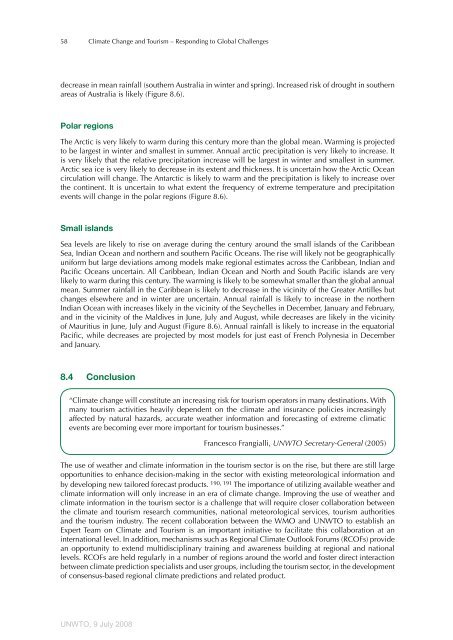Climate Change and Tourism - UNEP - Division of Technology ...
Climate Change and Tourism - UNEP - Division of Technology ...
Climate Change and Tourism - UNEP - Division of Technology ...
Create successful ePaper yourself
Turn your PDF publications into a flip-book with our unique Google optimized e-Paper software.
58 <strong>Climate</strong> <strong>Change</strong> <strong>and</strong> <strong>Tourism</strong> – Responding to Global Challenges<br />
decrease in mean rainfall (southern Australia in winter <strong>and</strong> spring). Increased risk <strong>of</strong> drought in southern<br />
areas <strong>of</strong> Australia is likely (Figure 8.6).<br />
Polar regions<br />
The Arctic is very likely to warm during this century more than the global mean. Warming is projected<br />
to be largest in winter <strong>and</strong> smallest in summer. Annual arctic precipitation is very likely to increase. It<br />
is very likely that the relative precipitation increase will be largest in winter <strong>and</strong> smallest in summer.<br />
Arctic sea ice is very likely to decrease in its extent <strong>and</strong> thickness. It is uncertain how the Arctic Ocean<br />
circulation will change. The Antarctic is likely to warm <strong>and</strong> the precipitation is likely to increase over<br />
the continent. It is uncertain to what extent the frequency <strong>of</strong> extreme temperature <strong>and</strong> precipitation<br />
events will change in the polar regions (Figure 8.6).<br />
Small isl<strong>and</strong>s<br />
Sea levels are likely to rise on average during the century around the small isl<strong>and</strong>s <strong>of</strong> the Caribbean<br />
Sea, Indian Ocean <strong>and</strong> northern <strong>and</strong> southern Pacific Oceans. The rise will likely not be geographically<br />
uniform but large deviations among models make regional estimates across the Caribbean, Indian <strong>and</strong><br />
Pacific Oceans uncertain. All Caribbean, Indian Ocean <strong>and</strong> North <strong>and</strong> South Pacific isl<strong>and</strong>s are very<br />
likely to warm during this century. The warming is likely to be somewhat smaller than the global annual<br />
mean. Summer rainfall in the Caribbean is likely to decrease in the vicinity <strong>of</strong> the Greater Antilles but<br />
changes elsewhere <strong>and</strong> in winter are uncertain. Annual rainfall is likely to increase in the northern<br />
Indian Ocean with increases likely in the vicinity <strong>of</strong> the Seychelles in December, January <strong>and</strong> February,<br />
<strong>and</strong> in the vicinity <strong>of</strong> the Maldives in June, July <strong>and</strong> August, while decreases are likely in the vicinity<br />
<strong>of</strong> Mauritius in June, July <strong>and</strong> August (Figure 8.6). Annual rainfall is likely to increase in the equatorial<br />
Pacific, while decreases are projected by most models for just east <strong>of</strong> French Polynesia in December<br />
<strong>and</strong> January.<br />
8.4 Conclusion<br />
“<strong>Climate</strong> change will constitute an increasing risk for tourism operators in many destinations. With<br />
many tourism activities heavily dependent on the climate <strong>and</strong> insurance policies increasingly<br />
affected by natural hazards, accurate weather information <strong>and</strong> forecasting <strong>of</strong> extreme climatic<br />
events are becoming ever more important for tourism businesses.”<br />
UNWTO, 9 July 2008<br />
Francesco Frangialli, UNWTO Secretary-General (2005)<br />
The use <strong>of</strong> weather <strong>and</strong> climate information in the tourism sector is on the rise, but there are still large<br />
opportunities to enhance decision-making in the sector with existing meteorological information <strong>and</strong><br />
by developing new tailored forecast products. 190, 191 The importance <strong>of</strong> utilizing available weather <strong>and</strong><br />
climate information will only increase in an era <strong>of</strong> climate change. Improving the use <strong>of</strong> weather <strong>and</strong><br />
climate information in the tourism sector is a challenge that will require closer collaboration between<br />
the climate <strong>and</strong> tourism research communities, national meteorological services, tourism authorities<br />
<strong>and</strong> the tourism industry. The recent collaboration between the WMO <strong>and</strong> UNWTO to establish an<br />
Expert Team on <strong>Climate</strong> <strong>and</strong> <strong>Tourism</strong> is an important initiative to facilitate this collaboration at an<br />
international level. In addition, mechanisms such as Regional <strong>Climate</strong> Outlook Forums (RCOFs) provide<br />
an opportunity to extend multidisciplinary training <strong>and</strong> awareness building at regional <strong>and</strong> national<br />
levels. RCOFs are held regularly in a number <strong>of</strong> regions around the world <strong>and</strong> foster direct interaction<br />
between climate prediction specialists <strong>and</strong> user groups, including the tourism sector, in the development<br />
<strong>of</strong> consensus-based regional climate predictions <strong>and</strong> related product.

















